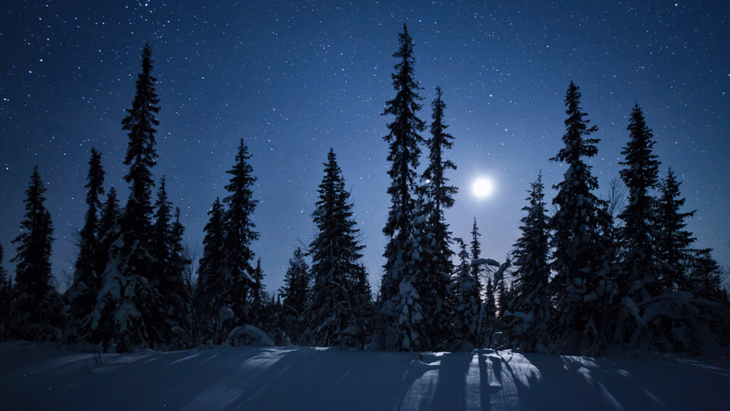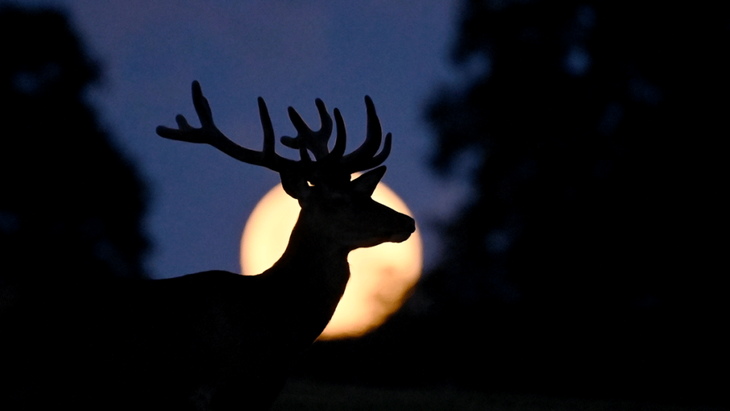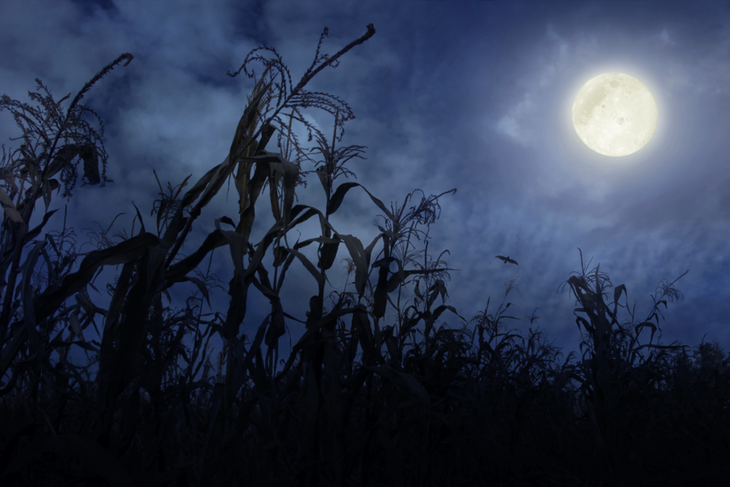Heading out the door? Read this article on the new Outside+ app available now on iOS devices for members! Download the app.
Indigenous cultures have long held a deep reverence for all things natural as well as celestial. The movement of the Moon through its cycles was regarded as a guide to the passage of time. More than mere timekeeping, this signpost was understood as a syncing of cosmic and earthly cycles. By attuning to the Moon, Indigenous peoples reinforced their role in the larger tapestry of existence.
“The Moon cycle is a sacred part of our culture and identity,” says Sara Thompson, a writer and yoga teacher who learned about the Moon’s relevance from her grandmother, a member of the Ojibwe tribe, the most populous Indigenous community in North America.
Each full Moon marks the completion of a month, a concept known as “moon time.” Cultures across North America ascribed names to each full Moon throughout the year based on significant seasonal activities that took place during its Moon time.
The number of Indigenous full Moon names is vast and diverse. Each tribe’s naming conventions are intricately tied to its cultural fabric, with hundreds of tribes across North America. Although certain names have faded in usage, their resonance with the natural world remains a testament to the rich heritage and wisdom of Indigenous cultures.
By acknowledging and respecting the traditional full Moon names, we cultivate a deeper appreciation for the interconnectedness of all living beings as well as our relationship with nature and the celestial realms. We also create a bridge between the wisdom of the past and contemporary life.
Full Moon Names and What They Mean
Preserving the Indigenous names of full Moons reminds us of a time when we existed more in harmony with the natural world. This relationship not only continues but has lessons to teach us, if only we pay attention.
January
Common Known As: Wolf Moon
Also: Great Spirit Moon, Ice Moon, Winter Moon, Cracking Tree Moon
At the turn of the new year, the nights are long and the temperatures hover above freezing. Here in the dead of winter, food is scarce and energies are low. Wolves would howl into the night, piercing the cold air with the resonance of their calls. It was once thought the cries were due to hunger, although we now understand they were relied on to locate the rest of the pack, define territories, and commune socially. Because of the increased vocality during this time of the year, the January Moon was dubbed the Wolf Moon.

February
Common Known As: Snow Moon
Also: Sucker Fish Moon, Full Hunger Moon, Eagle Moon, Deep Snow Moon
Typically a time of heavy snowfall in North America, February is when winter gives one final flourish. With the ground blanketed in white, it’s easy to understand why the full Moon name known by many tribes is the Snow Moon. The Ojibwe tribe, however, named it in honor of the Catostomidae or Sucker Fish, which was a plentiful and essential source of nutrition for Indigenous Americans throughout winter. (Remnants of stone fish traps still exist along spawning rivers in Ahjumawi Lava Springs State Park in northeastern California, which was inhabited by the Achomawi band of Pit River tribe of Native Americans.)
March
Common Known As: Worm Moon
Also: Hard Crust on the Snow Moon, Crow Moon, Goose Moon, Wind Moon
With rising temperatures, the snow starts to melt, transforming the ground into mud. The naming of the March Moon is oft attributed to the terrain’s turning point, a time that awakens the worms and entices the return of the birds who prey on them. An alternative interpretation from the late 1700s was described by explorer, cartographer, and author Jonathan Carver, who suggested that the term “worm” pertains to larvae emerging from tree bark and other sheltered places during spring.
April
Common Known As: Pink Moon
Also: Maple Sap Boiling Moon, Sugarbushing Moon, Frog Moon, Loon Moon
As the first wildflowers emerge, wild ground phlox becomes noticeable. Colloquially referred to as “moss pink,” this low-growing plant once blanketed eastern portions of North America each April with swaths of pink, blue, purple, and white. Alternative names associated with this season herald the characteristics or characters commonly associated with the time of year.
May
Common Known As: Flower Moon
Also: Budding Moon, Snake Moon, Planting Moon, Dancing Moon
This month, too, brings wildflowers that overwhelm the land with an array of sights and smells. Some May Moon names honor the budding and blooming, while other lunar titles reflect a more practical mindset by referencing this as the time when crops are planted.
June
Common Known As: Strawberry Moon
Also: Gardening Moon, River Moon, Moon of Birthing
As summer’s heat begins to take hold, wild fruits and edible plants begin to prosper. Strawberries, once plentiful throughout much of the United States, heralded a new chapter in the natural cycle, one of abundance. Indigenous tribes almost unanimously refer to the June Moon as the Strawberry Moon, although it was sometimes known as Moon of Birthing, which similarly references the vital fertility of the earth.

July
Common Known As: Buck Moon
Also: Mid-Summer Moon, Blueberry Moon, Flying Moon, Honey Bee Moon
In July, the naming of the Full Moon begins to turn away from plants and back toward the animal world. During summer, the antlers of bucks, or male deer, are growing at full force. With an abundance of plant life, deer and buck are rampant in the North American plains and an important source of food not just for the summer, but for the upcoming colder months given the preservation techniques of smoking and drying.
August
Common Known As: Sturgeon Moon
Also: Ricing Moon, Blackberry Moon, Dry Moon, Hot Moon
The Sturgeon Moon of August refers to a species of fish that can be found along the Atlantic Coast, stretching from the Gulf of Mexico to Newfoundland. Sturgeon also inhabit the vast expanse of the Great Lakes region and thrive within the waterways of the St. Lawrence, Missouri, and Mississippi rivers. Several species can grow to be more than 12 feet long, making this colossal fish a deeply admired and sometimes spiritualized source of nutrition and life for tribes.

September
Common Known As: Harvest Moon
Also: Leaves Changing Color Moon, Corn Moon, Moose Moon, Gourd Moon, Someone Harvests Moon
The September Moon signifies the fall crops being ready for harvest, yet another crucial shift in nature’s cycles. As the fall equinox nears and the crops are gathered, communal celebrations were common. Tribes would gather to feast, dance, connect, and offer thanks before beginning preparations for the coming cold.
October
Common Known As: Hunter’s Moon
Also: Falling Leaves Moon, Someone Stores Food Moon, Hunting Moon
October marks the optimal time for hunting, as game is at its healthiest state following summer feasting. Also, as trees begin to lose their leaves, there is little shelter for prey to hide. For hunter-gatherers, the significance of hunting and stockpiling resources is critical to survival. As the nights grow longer and colder, this time is opportune for gathering food and storing furs for the approaching winter months. This is the Hunter’s Moon.
November
Common Known As: Beaver Moon
Also: Freezing Moon, Whitefish Moon, First Snow Moon, Little Winter Moon
As winter slowly begins to take hold, there is a final month of hunting. Beavers, too, are making their final preparations for the coming winter and retreating to their lodges, which makes them easier to hunt. Alternate full Moon names for November speak to the onset of winter.
December
Common Known As: Cold Moon
Also: Little Spirits Moon, Big Winter Moon, Long Night Moon, Storytelling Moon
In December, the winter solstice comes and the seasonal cycle reaches its origin once again. The long nights and cold temperatures bring back the snow and encourage families and tribes to gather by the fire. As winter fastens its grip on the land, activities shift from hunting and gardening to storytelling, mending, and conversing with loved ones. The cold may seem grueling and the nights long, but there is the knowing that the Sun will return and the cycle will begin anew.
About Our Contributor
Sierra is a writer and modern witchy woman living in Oregon. She’s been practicing yoga for nearly a decade and completed her teacher training in 2018. She writes and teaches about connection—connection to the body, to nature, and to the powerful energies of the universe. In 2017, she founded her media brand, The Local Mystic, an educational hub devoted to mindful, mystical living for women. Sierra loves to guide people to their witchy side by helping them deepen their spiritual studies and ritualize their lives. Through The Local Mystic, she’s written books, plus hosted women’s circles and wellness retreats worldwide. For free yoga and witchy wisdom, find Sierra on Instagram @thelocalmystic and on YouTube. And check out her book, Your Year of Magic.